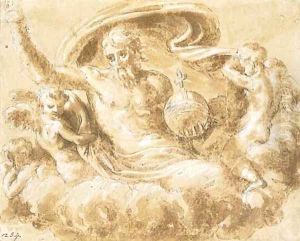Bartolommeo Ramenghi The Elder, Il Bagnacavallo Paintings
Bartolommeo Ramenghi, known as Il Bagnacavallo after his birthplace Bagnacavallo near Ravenna, Italy, was a notable figure in the Italian Renaissance art movement. Born in 1484, his artistic journey was profoundly influenced by the work of Raphael, under whom he is believed to have studied, although direct documentation of this mentorship is sparse. His style, however, shows a clear Raphaelite influence, characterized by grace, clarity of form, and a serene harmonization of his compositions which align him closely with the High Renaissance ideals.
Bagnacavallo's work encompasses a range of religious and mythological themes, executed in both fresco and oil mediums. He was particularly adept at creating altarpieces, a genre in which his skillful use of color and light is evident. His contributions to the churches and public buildings in Bologna, where he spent a considerable part of his career, have been highly praised for their elegance and devotion. Among his notable works are the frescoes in the church of San Michele in Bosco and the altarpiece in the church of Santa Maria della Pace in Bologna. These works exemplify his ability to blend narrative clarity with emotional depth, a hallmark of his mature style.
Beyond his artistic achievements, Bagnacavallo played a significant role in the Bolognese school of painting, influencing a generation of artists in the region. His legacy is marked not only by his own creations but also by the continuation of his stylistic traits in the works of his followers and students. Despite facing competition from other prominent artists of his time, including his contemporaries and those who followed the more dynamic Mannerist style, Bagnacavallo maintained a distinctive approach that emphasized balanced compositions and a serene, classical beauty.
Bagnacavallo's death in 1542 marked the end of an era in the Italian Renaissance, but his works continue to be celebrated for their contribution to the development of Italian art. His ability to harmonize the influences of his predecessors, particularly Raphael, with his own artistic vision, has ensured his place among the esteemed artists of his time. Through his paintings, Bagnacavallo communicated a deep reverence for the sacred, a characteristic that has made his works enduring subjects of study and admiration in the field of art history.
